Class I histone deacetylase inhibitor suppresses vasculogenic mimicry by enhancing the expression of tumor suppressor and anti-angiogenesis genes in aggressive human TNBC cells
- Authors:
- Aparna Maiti
- Qianya Qi
- Xuan Peng
- Li Yan
- Kazuaki Takabe
- Nitai C. Hait
-
Affiliations: Division of Breast Surgery, Department of Surgical Oncology, Roswell Park Comprehensive Cancer Center, Buffalo, NY 14263, USA, Department of Biostatistics and Bioinformatics, Roswell Park Comprehensive Cancer Center, Buffalo, NY 14263, USA - Published online on: May 6, 2019 https://doi.org/10.3892/ijo.2019.4796
- Pages: 116-130
-
Copyright: © Maiti et al. This is an open access article distributed under the terms of Creative Commons Attribution License.
This article is mentioned in:
Abstract
 |
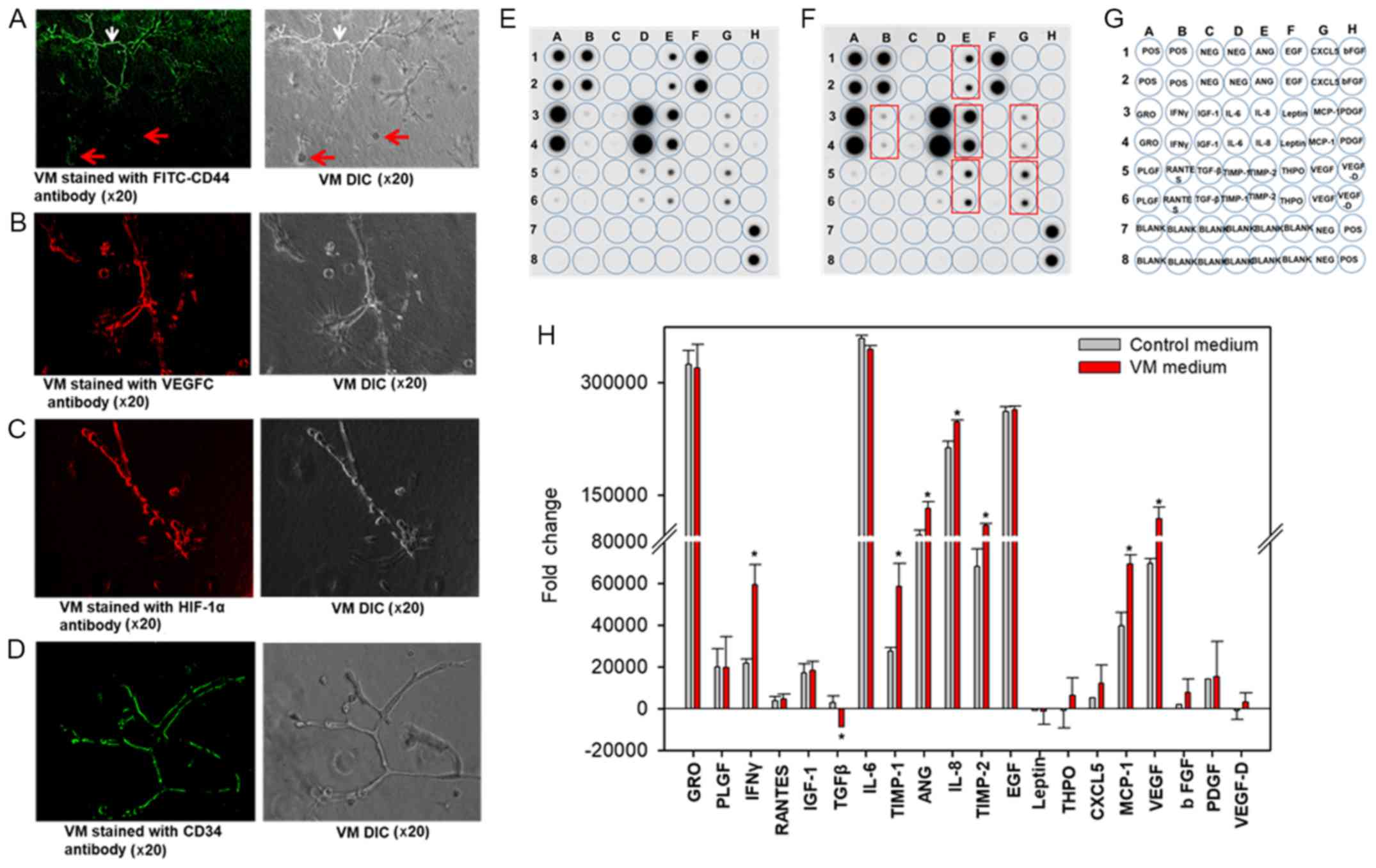 |
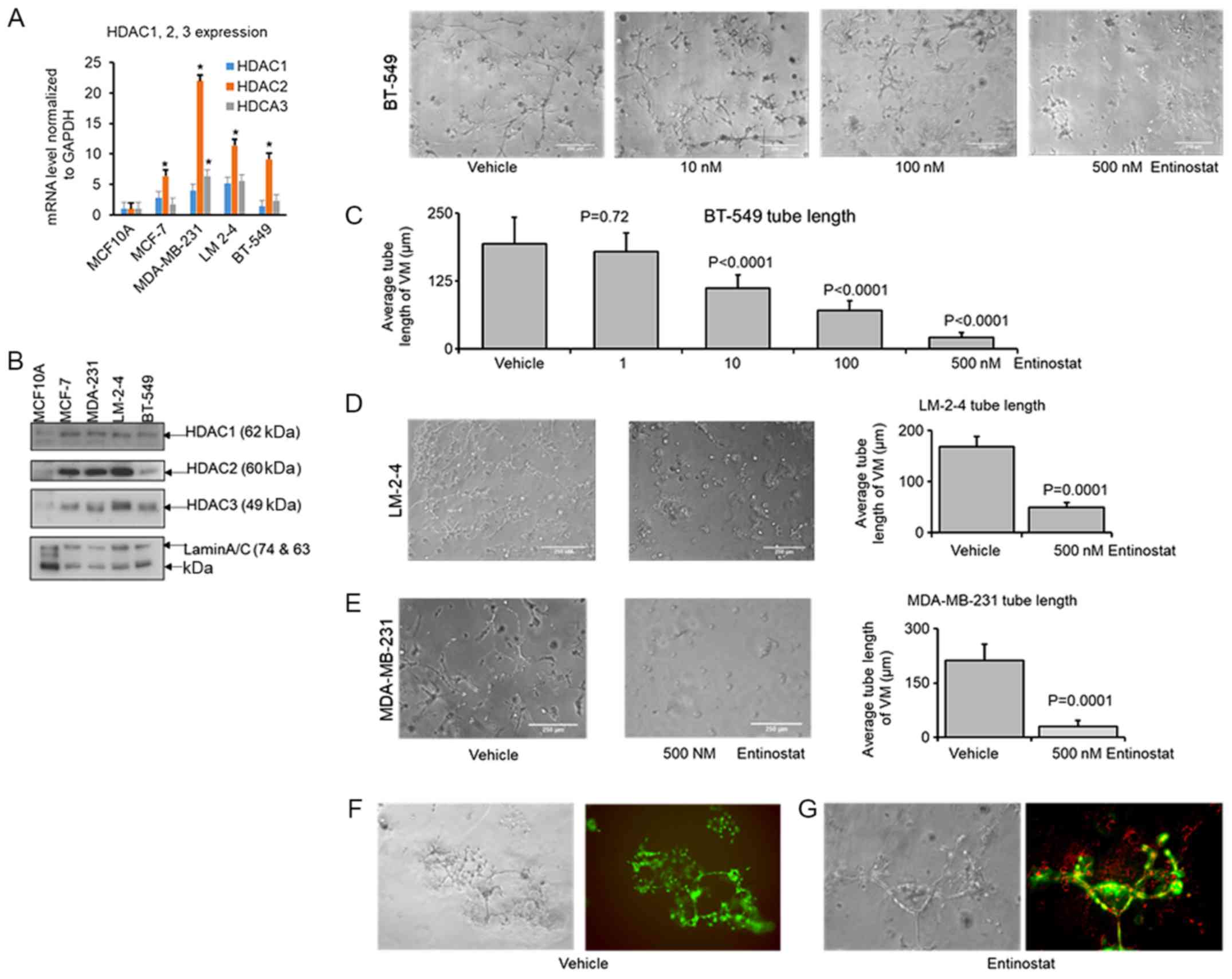 |
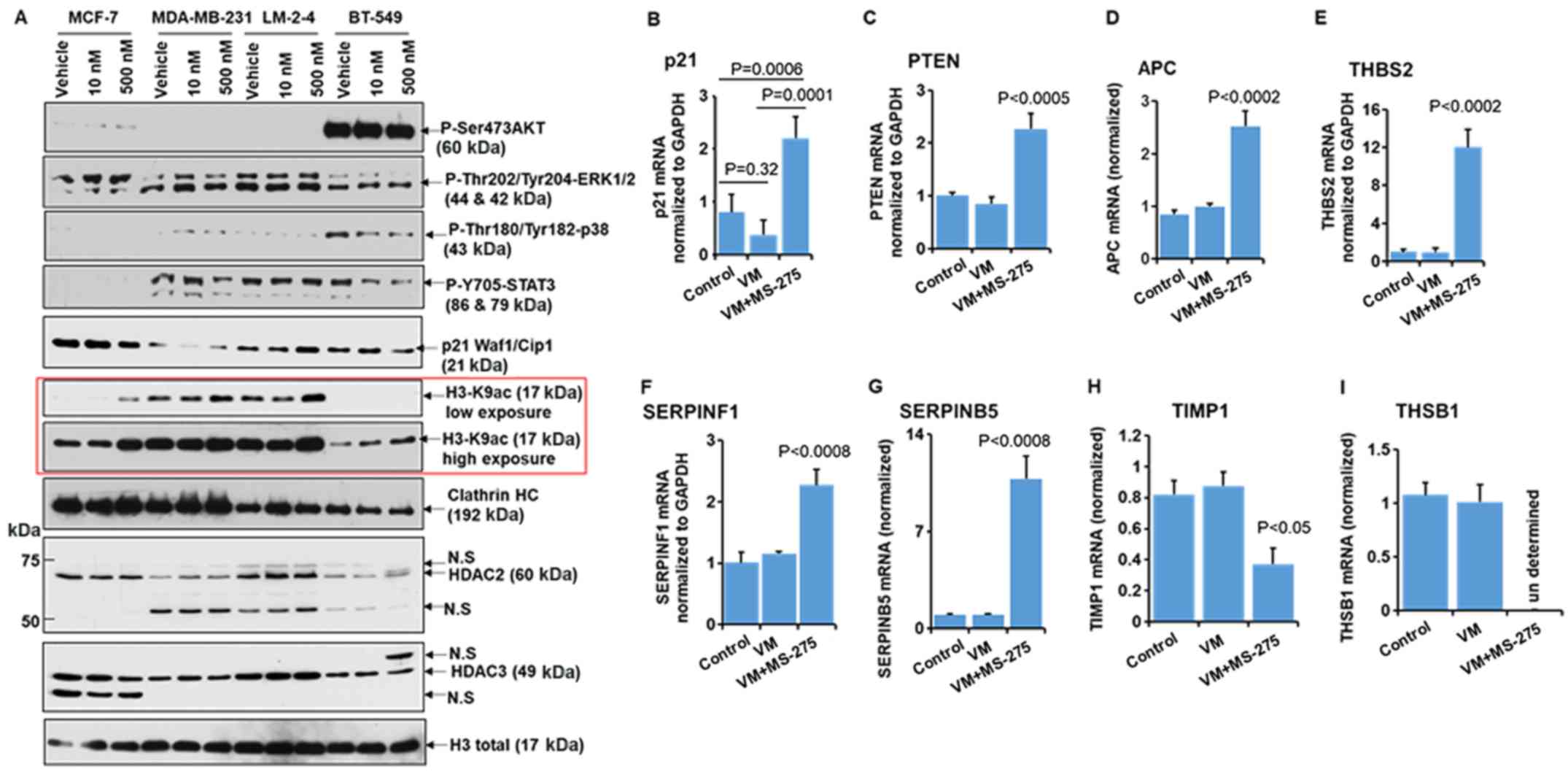 |
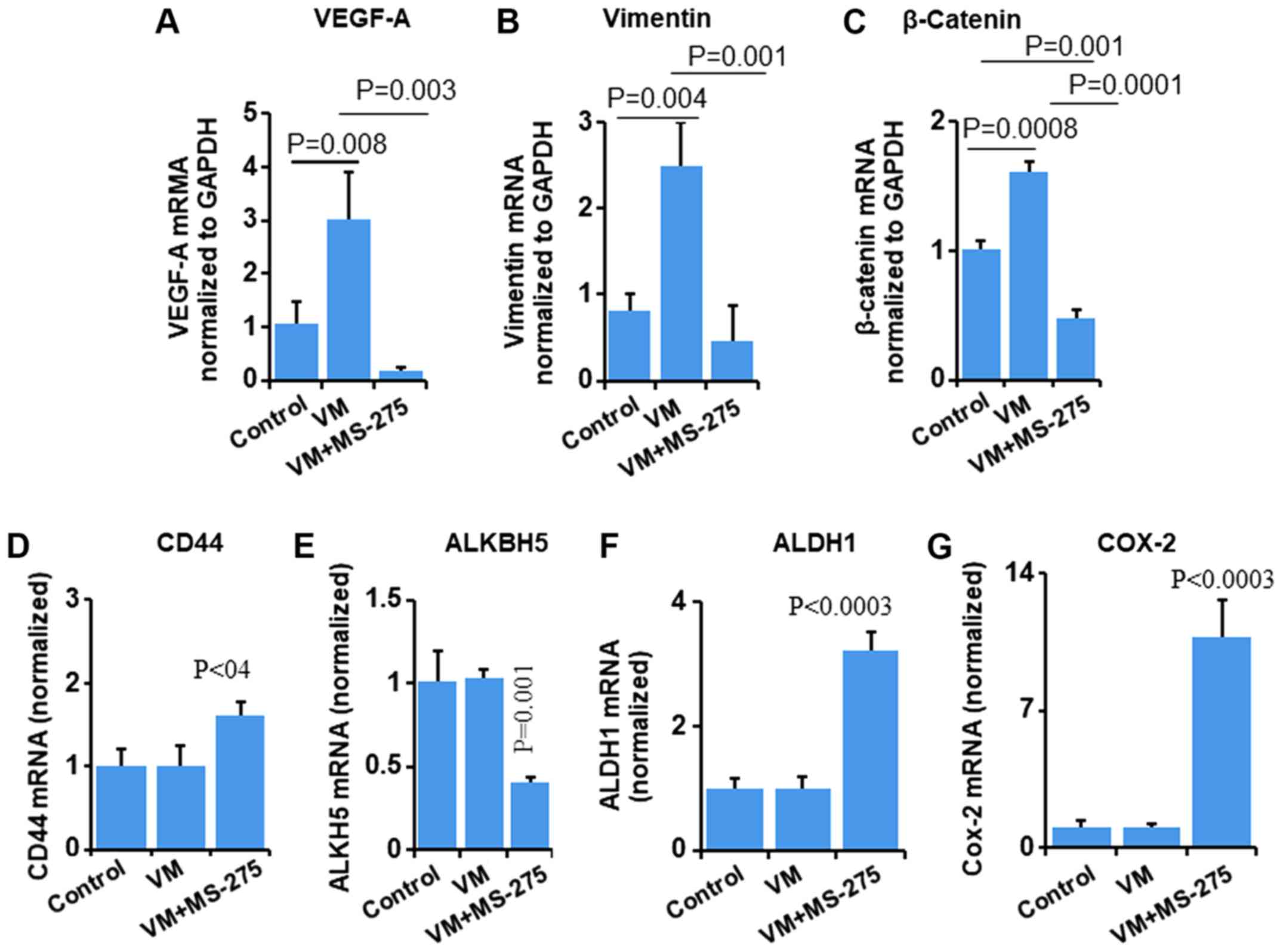 |
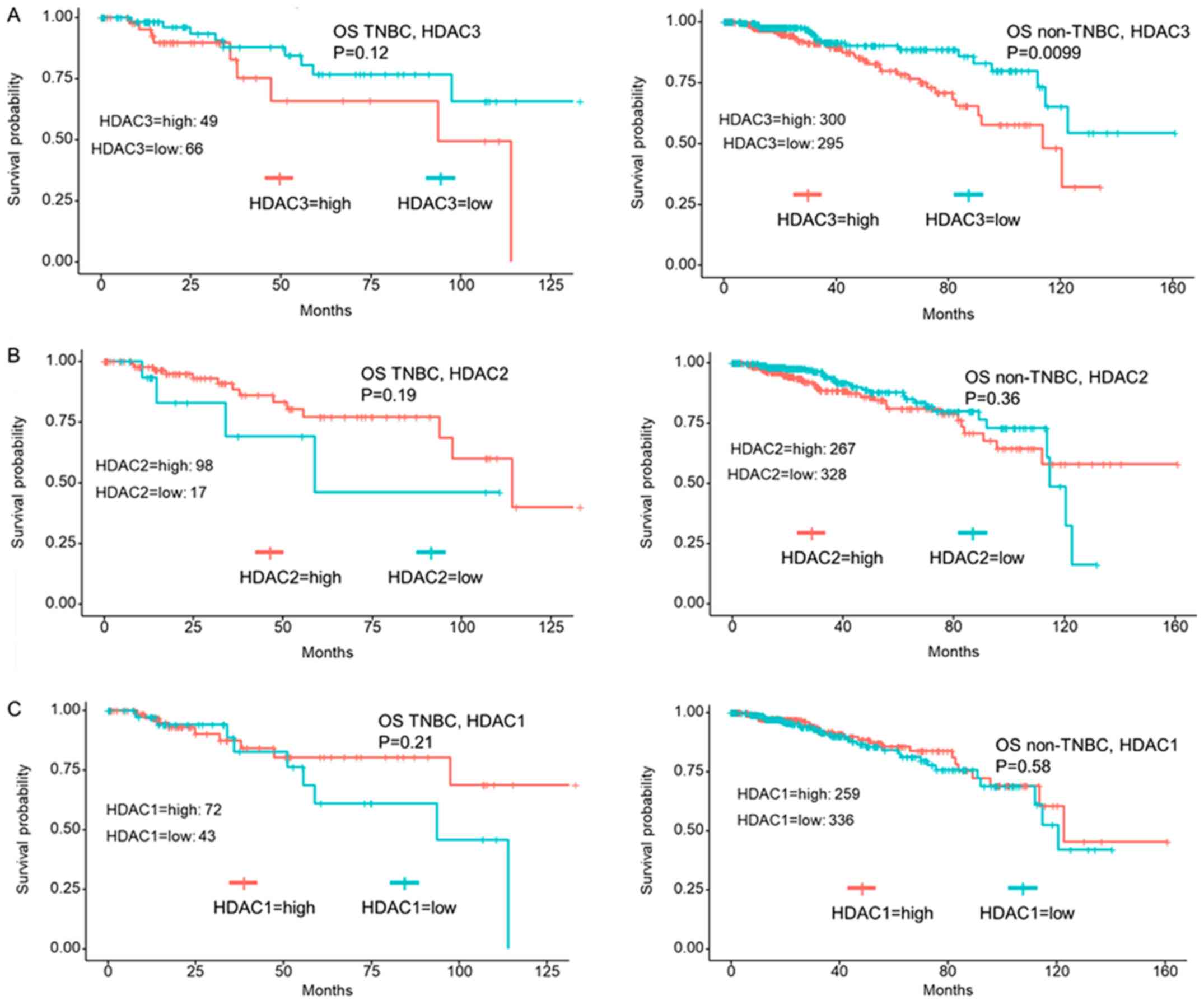 |
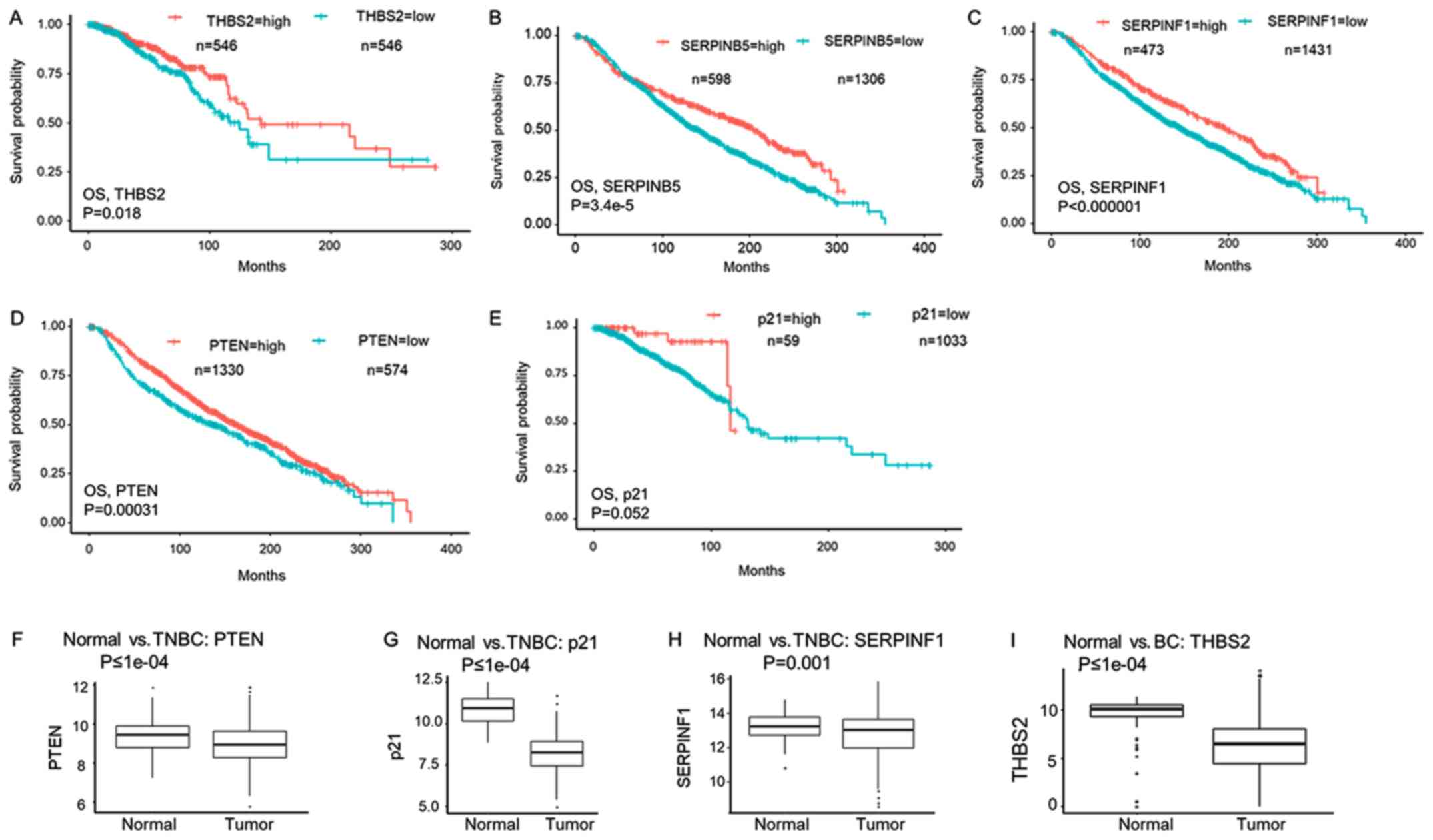 |
|
Hanahan D and Weinberg RA: Hallmarks of cancer: The next generation. Cell. 144:646–674. 2011. View Article : Google Scholar : PubMed/NCBI | |
|
Gacche RN: Compensatory angiogenesis and tumor refractoriness. Oncogenesis. 4:e1532015. View Article : Google Scholar : PubMed/NCBI | |
|
Pinto MP, Sotomayor P, Carrasco-Avino G, Corvalan AH and Owen GI: Escaping antiangiogenic therapy: Strategies employed by cancer cells. Int J Mol Sci. 17:E14892016. View Article : Google Scholar : PubMed/NCBI | |
|
Maniotis AJ, Folberg R, Hess A, Seftor EA, Gardner LM, Pe'er J, Trent JM, Meltzer PS and Hendrix MJ: Vascular channel formation by human melanoma cells in vivo and in vitro: Vasculogenic mimicry. Am J Pathol. 155:739–752. 1999. View Article : Google Scholar : PubMed/NCBI | |
|
Plate KH, Scholz A and Dumont DJ: Tumor angiogenesis and anti-angiogenic therapy in malignant gliomas revisited. Acta Neuropathol. 124:763–775. 2012. View Article : Google Scholar : PubMed/NCBI | |
|
Folberg R and Maniotis AJ: Vasculogenic mimicry. APMIS. 112:508–525. 2004. View Article : Google Scholar : PubMed/NCBI | |
|
Folberg R, Hendrix MJ and Maniotis AJ: Vasculogenic mimicry and tumor angiogenesis. Am J Pathol. 156:361–381. 2000. View Article : Google Scholar : PubMed/NCBI | |
|
Clemente M, Pérez-Alenza MD, Illera JC and Peña L: Histological, immunohistological, and ultrastructural description of vasculogenic mimicry in canine mammary cancer. Vet Pathol. 47:265–274. 2010. View Article : Google Scholar : PubMed/NCBI | |
|
Seftor RE, Hess AR, Seftor EA, Kirschmann DA, Hardy KM, Margaryan NV and Hendrix MJ: Tumor cell vasculogenic mimicry: From controversy to therapeutic promise. Am J Pathol. 181:1115–1125. 2012. View Article : Google Scholar : PubMed/NCBI | |
|
Kirschmann DA, Seftor EA, Hardy KM, Seftor RE and Hendrix MJ: Molecular pathways: vasculogenic mimicry in tumor cells: diagnostic and therapeutic implications. Clin Cancer Res. 18:2726–2732. 2012. View Article : Google Scholar : PubMed/NCBI | |
|
Shirakawa K, Tsuda H, Heike Y, Kato K, Asada R, Inomata M, Sasaki H, Kasumi F, Yoshimoto M, Iwanaga T, et al: Absence of endothelial cells, central necrosis, and fibrosis are associated with aggressive inflammatory breast cancer. Cancer Res. 61:445–451. 2001.PubMed/NCBI | |
|
Sood AK, Seftor EA, Fletcher MS, Gardner LM, Heidger PM, Buller RE, Seftor RE and Hendrix MJ: Molecular determinants of ovarian cancer plasticity. Am J Pathol. 158:1279–1288. 2001. View Article : Google Scholar : PubMed/NCBI | |
|
Sood AK, Fletcher MS, Zahn CM, Gruman LM, Coffin JE, Seftor EA and Hendrix MJ: The clinical significance of tumor cell-lined vasculature in ovarian carcinoma: Implications for anti-vasculogenic therapy. Cancer Biol Ther. 1:661–664. 2002. View Article : Google Scholar | |
|
Sharma N, Seftor RE, Seftor EA, Gruman LM, Heidger PM Jr, Cohen MB, Lubaroff DM and Hendrix MJ: Prostatic tumor cell plasticity involves cooperative interactions of distinct phenotypic subpopulations: Role in vasculogenic mimicry. Prostate. 50:189–201. 2002. View Article : Google Scholar : PubMed/NCBI | |
|
Passalidou E, Trivella M, Singh N, Ferguson M, Hu J, Cesario A, Granone P, Nicholson AG, Goldstraw P, Ratcliffe C, et al: Vascular phenotype in angiogenic and non-angiogenic lung non-small cell carcinomas. Br J Cancer. 86:244–249. 2002. View Article : Google Scholar : PubMed/NCBI | |
|
Yue WY and Chen ZP: Does vasculogenic mimicry exist in astrocytoma? J Histochem Cytochem. 53:997–1002. 2005. View Article : Google Scholar : PubMed/NCBI | |
|
Sun B, Zhang D, Zhang S, Zhang W, Guo H and Zhao X: Hypoxia influences vasculogenic mimicry channel formation and tumor invasion-related protein expression in melanoma. Cancer Lett. 249:188–197. 2007. View Article : Google Scholar | |
|
Bianchini G, Balko JM, Mayer IA, Sanders ME and Gianni L: Triple-negative breast cancer: Challenges and opportunities of a heterogeneous disease. Nat Rev Clin Oncol. 13:674–690. 2016. View Article : Google Scholar : PubMed/NCBI | |
|
Bayraktar S and Glück S: Molecularly targeted therapies for metastatic triple-negative breast cancer. Breast Cancer Res Treat. 138:21–35. 2013. View Article : Google Scholar : PubMed/NCBI | |
|
Ribatti D, Nico B, Ruggieri S, Tamma R, Simone G and Mangia A: Angiogenesis and antiangiogenesis in triple-negative breast cancer. Transl Oncol. 9:453–457. 2016. View Article : Google Scholar : PubMed/NCBI | |
|
Sun H, Zhang D, Yao Z, Lin X, Liu J, Gu Q, Dong X, Liu F, Wang Y, Yao N, et al: Anti-angiogenic treatment promotes triple-negative breast cancer invasion via vasculogenic mimicry. Cancer Biol Ther. 18:205–213. 2017. View Article : Google Scholar : PubMed/NCBI | |
|
Shen Y, Quan J, Wang M, Li S and Yang J, Lv M, Chen Z, Zhang L, Zhao X and Yang J: Tumor vasculogenic mimicry formation as an unfavorable prognostic indicator in patients with breast cancer. Oncotarget. 8:56408–56416. 2017.PubMed/NCBI | |
|
Shao F, Sun H and Deng CX: Potential therapeutic targets of triple-negative breast cancer based on its intrinsic subtype. Oncotarget. 8:73329–73344. 2017. View Article : Google Scholar : PubMed/NCBI | |
|
Qi L, Song W, Liu Z, Zhao X, Cao W and Sun B: Wnt3a promotes the vasculogenic mimicry formation of colon cancer via Wnt/beta-catenin signaling. Int J Mol Sci. 16:18564–18579. 2015. View Article : Google Scholar : PubMed/NCBI | |
|
Liu Z, Sun B, Qi L, Li H, Gao J and Leng X: Zinc finger E-box binding homeobox 1 promotes vasculogenic mimicry in colorectal cancer through induction of epithelial-to-mesenchymal transition. Cancer Sci. 103:813–820. 2012. View Article : Google Scholar : PubMed/NCBI | |
|
Demou ZN and Hendrix MJ: Microgenomics profile the endogenous angiogenic phenotype in subpopulations of aggressive melanoma. J Cell Biochem. 105:562–573. 2008. View Article : Google Scholar : PubMed/NCBI | |
|
Su M, Feng YJ, Yao LQ, Cheng MJ, Xu CJ, Huang Y, Zhao YQ and Jiang H: Plasticity of ovarian cancer cell SKOV3ip and vasculogenic mimicry in vivo. Int J Gynecol Cancer. 18:476–486. 2008. View Article : Google Scholar | |
|
Xu B, Li J, Liu X, Li C and Chang X: TXNDC5 is a cervical tumor susceptibility gene that stimulates cell migration, vasculogenic mimicry and angiogenesis by down-regulating SERPINF1 and TRAF1 expression. Oncotarget. 8:91009–91024. 2017.PubMed/NCBI | |
|
Bittner M, Meltzer P, Chen Y, Jiang Y, Seftor E, Hendrix M, Radmacher M, Simon R, Yakhini Z, Ben-Dor A, et al: Molecular classification of cutaneous malignant melanoma by gene expression profiling. Nature. 406:536–540. 2000. View Article : Google Scholar : PubMed/NCBI | |
|
Li M, Edamatsu H, Kitazawa R, Kitazawa S and Kataoka T: Phospholipase Cepsilon promotes intestinal tumorigenesis of Apc(Min/+) mice through augmentation of inflammation and angiogenesis. Carcinogenesis. 30:1424–1432. 2009. View Article : Google Scholar : PubMed/NCBI | |
|
Wu S, Yu L, Cheng Z, Song W, Zhou L and Tao Y: Expression of maspin in non-small cell lung cancer and its relationship to vasculogenic mimicry. J Huazhong Univ Sci Technolog Med Sci. 32:346–352. 2012. View Article : Google Scholar : PubMed/NCBI | |
|
Mirmohammadsadegh A, Marini A, Nambiar S, Hassan M, Tannapfel A, Ruzicka T and Hengge UR: Epigenetic silencing of the PTEN gene in melanoma. Cancer Res. 66:6546–6552. 2006. View Article : Google Scholar : PubMed/NCBI | |
|
Li Y, Chen H, Hardy TM and Tollefsbol TO: Epigenetic regulation of multiple tumor-related genes leads to suppression of breast tumorigenesis by dietary genistein. PLoS One. 8:e543692013. View Article : Google Scholar : PubMed/NCBI | |
|
Hu E, Dul E, Sung CM, Chen Z, Kirkpatrick R, Zhang GF, Johanson K, Liu R, Lago A, Hofmann G, et al: Identification of novel isoform-selective inhibitors within class I histone deacetylases. J Pharmacol Exp Ther. 307:720–728. 2003. View Article : Google Scholar : PubMed/NCBI | |
|
Vannini A, Volpari C, Filocamo G, Casavola EC, Brunetti M, Renzoni D, Chakravarty P, Paolini C, De Francesco R, Gallinari P, et al: Crystal structure of a eukaryotic zinc-dependent histone deacetylase, human HDAC8, complexed with a hydroxamic acid inhibitor. Proc Natl Acad Sci USA. 101:15064–15069. 2004. View Article : Google Scholar : PubMed/NCBI | |
|
Inoue S, Mai A, Dyer MJ and Cohen GM: Inhibition of histone deacetylase class I but not class II is critical for the sensitization of leukemic cells to tumor necrosis factor-related apoptosis-inducing ligand-induced apoptosis. Cancer Res. 66:6785–6792. 2006. View Article : Google Scholar : PubMed/NCBI | |
|
Bracker TU, Sommer A, Fichtner I, Faus H, Haendler B and Hess-Stumpp H: Efficacy of MS-275, a selective inhibitor of class I histone deacetylases, in human colon cancer models. Int J Oncol. 35:909–920. 2009.PubMed/NCBI | |
|
Ryan QC, Headlee D, Acharya M, Sparreboom A, Trepel JB, Ye J, Figg WD, Hwang K, Chung EJ, Murgo A, et al: Phase I and pharmacokinetic study of MS-275, a histone deacetylase inhibitor, in patients with advanced and refractory solid tumors or lymphoma. J Clin Oncol. 23:3912–3922. 2005. View Article : Google Scholar : PubMed/NCBI | |
|
Shah P, Gau Y and Sabnis G: Histone deacetylase inhibitor entinostat reverses epithelial to mesenchymal transition of breast cancer cells by reversing the repression of E-cadherin. Breast Cancer Res Treat. 143:99–111. 2014. View Article : Google Scholar | |
|
Schech A, Kazi A, Yu S, Shah P and Sabnis G: Histone deacetylase inhibitor entinostat inhibits tumor-initiating cells in triple-negative breast cancer cells. Mol Cancer Ther. 14:1848–1857. 2015. View Article : Google Scholar : PubMed/NCBI | |
|
Gangavarapu KJ, Azabdaftari G, Morrison CD, Miller A, Foster BA and Huss WJ: Aldehyde dehydrogenase and ATP binding cassette transporter G2 (ABCG2) functional assays isolate different populations of prostate stem cells where ABCG2 function selects for cells with increased stem cell activity. Stem Cell Res Ther. 4:1322013. View Article : Google Scholar : | |
|
Maiti A, Takabe K and Hait NC: Metastatic triple-negative breast cancer is dependent on SphKs/S1P signaling for growth and survival. Cell Signal. 32:85–92. 2017. View Article : Google Scholar : PubMed/NCBI | |
|
Livak KJ and Schmittgen TD: Analysis of relative gene expression data using real-time quantitative PCR and the 2(-Delta Delta C(T)) method. Methods. 25:402–408. 2001. View Article : Google Scholar | |
|
Tavallai M, Hamed HA, Roberts JL, Cruickshanks N, Chuckalovcak J, Poklepovic A, Booth L and Dent P: Nexavar/Stivarga and viagra interact to kill tumor cells. J Cell Physiol. 230:2281–2298. 2015. View Article : Google Scholar : PubMed/NCBI | |
|
LeBlanc M, Jacobson J and Crowley J: Partitioning and peeling for constructing prognostic groups. Stat Methods Med Res. 11:247–274. 2002. View Article : Google Scholar : PubMed/NCBI | |
|
Benton G, Arnaoutova I, George J, Kleinman HK and Koblinski J: Matrigel: From discovery and ECM mimicry to assays and models for cancer research. Adv Drug Deliv Rev. 79-80:3–18. 2014. View Article : Google Scholar : PubMed/NCBI | |
|
Izawa Y, Kashii-Magaribuchi K, Yoshida K, Nosaka M, Tsuji N, Yamamoto A, Kuroyanagi K, Tono K, Tanihata M, Imanishi M, et al: Stem-like human breast cancer cells initiate vasculogenic mimicry on matrigel. Acta Histochem Cytochem. 51:173–183. 2018. View Article : Google Scholar | |
|
Williamson SC, Metcalf RL, Trapani F, Mohan S, Antonello J, Abbott B, Leong HS, Chester CP, Simms N, Polanski R, et al: Vasculogenic mimicry in small cell lung cancer. Nat Commun. 7:133222016. View Article : Google Scholar : PubMed/NCBI | |
|
Hendrix MJ, Seftor EA, Hess AR and Seftor RE: Vasculogenic mimicry and tumour-cell plasticity: Lessons from melanoma. Nat Rev Cancer. 3:411–421. 2003. View Article : Google Scholar : PubMed/NCBI | |
|
Paulis YW, Huijbers EJ, van der Schaft DW, Soetekouw PM, Pauwels P, Tjan-Heijnen VC and Griffioen AW: CD44 enhances tumor aggressiveness by promoting tumor cell plasticity. Oncotarget. 6:19634–19646. 2015. View Article : Google Scholar : PubMed/NCBI | |
|
Meyer MJ, Fleming JM, Ali MA, Pesesky MW, Ginsburg E and Vonderhaar BK: Dynamic regulation of CD24 and the invasive, CD44posCD24neg phenotype in breast cancer cell lines. Breast Cancer Res. 11:R822009. View Article : Google Scholar : PubMed/NCBI | |
|
Fillmore CM and Kuperwasser C: Human breast cancer cell lines contain stem-like cells that self-renew, give rise to phenotypically diverse progeny and survive chemotherapy. Breast Cancer Res. 10:R252008. View Article : Google Scholar : PubMed/NCBI | |
|
Ricci-Vitiani L, Pallini R, Biffoni M, Todaro M, Invernici G, Cenci T, Maira G, Parati EA, Stassi G, Larocca LM, et al: Tumour vascularization via endothelial differentiation of glioblastoma stem-like cells. Nature. 468:824–828. 2010. View Article : Google Scholar : PubMed/NCBI | |
|
Aikins AR, Kim M, Raymundo B and Kim CW: Downregulation of transgelin blocks interleukin-8 utilization and suppresses vasculogenic mimicry in breast cancer cells. Exp Biol Med (Maywood). 242:573–583. 2017. View Article : Google Scholar | |
|
Shirakawa K, Kobayashi H, Sobajima J, Hashimoto D, Shimizu A and Wakasugi H: Inflammatory breast cancer: Vasculogenic mimicry and its hemodynamics of an inflammatory breast cancer xenograft model. Breast Cancer Res. 5:136–139. 2003. View Article : Google Scholar : PubMed/NCBI | |
|
Basu GD, Liang WS, Stephan DA, Wegener LT, Conley CR, Pockaj BA and Mukherjee P: A novel role for cyclooxygenase-2 in regulating vascular channel formation by human breast cancer cells. Breast Cancer Res. 8:R692006. View Article : Google Scholar : PubMed/NCBI | |
|
Geng L, Chaudhuri A, Talmon G, Wisecarver JL and Wang J: TGF-Beta suppresses VEGFA-mediated angiogenesis in colon cancer metastasis. PLoS One. 8:e599182013. View Article : Google Scholar : PubMed/NCBI | |
|
Ferrari G, Cook BD, Terushkin V, Pintucci G and Mignatti P: Transforming growth factor-beta 1 (TGF-beta1) induces angiogenesis through vascular endothelial growth factor (VEGF)-mediated apoptosis. J Cell Physiol. 219:449–458. 2009. View Article : Google Scholar : PubMed/NCBI | |
|
Krusche CA, Wülfing P, Kersting C, Vloet A, Böcker W, Kiesel L, Beier HM and Alfer J: Histone deacetylase-1 and -3 protein expression in human breast cancer: A tissue microarray analysis. Breast Cancer Res Treat. 90:15–23. 2005. View Article : Google Scholar : PubMed/NCBI | |
|
Müller BM, Jana L, Kasajima A, Lehmann A, Prinzler J, Budczies J, Winzer KJ, Dietel M, Weichert W and Denkert C: Differential expression of histone deacetylases HDAC1, 2 and 3 in human breast cancer - overexpression of HDAC2 and HDAC3 is associated with clinicopathological indicators of disease progression. BMC Cancer. 13:2152013. View Article : Google Scholar : | |
|
Minamiya Y, Ono T, Saito H, Takahashi N, Ito M, Mitsui M, Motoyama S and Ogawa J: Expression of histone deacetylase 1 correlates with a poor prognosis in patients with adenocarcinoma of the lung. Lung Cancer. 74:300–304. 2011. View Article : Google Scholar : PubMed/NCBI | |
|
Zhang Z, Yamashita H, Toyama T, Sugiura H, Ando Y, Mita K, Hamaguchi M, Hara Y, Kobayashi S and Iwase H: Quantitation of HDAC1 mRNA expression in invasive carcinoma of the breast*. Breast Cancer Res Treat. 94:11–16. 2005. View Article : Google Scholar : PubMed/NCBI | |
|
Kim MS, Kwon HJ, Lee YM, Baek JH, Jang JE, Lee SW, Moon EJ, Kim HS, Lee SK, Chung HY, et al: Histone deacetylases induce angiogenesis by negative regulation of tumor suppressor genes. Nat Med. 7:437–443. 2001. View Article : Google Scholar : PubMed/NCBI | |
|
Liu X, Wang JH, Li S, Li LL, Huang M, Zhang YH, Liu Y, Yang YT, Ding R and Ke YQ: Histone deacetylase 3 expression correlates with vasculogenic mimicry through the phos-phoinositide3-kinase/ERK-MMP-laminin5γ2 signaling pathway. Cancer Sci. 106:857–866. 2015. View Article : Google Scholar : PubMed/NCBI | |
|
Knipstein J and Gore L: Entinostat for treatment of solid tumors and hematologic malignancies. Expert Opin Investig Drugs. 20:1455–1467. 2011. View Article : Google Scholar : PubMed/NCBI | |
|
Merino VF, Nguyen N, Jin K, Sadik H, Cho S, Korangath P, Han L, Foster YM, Zhou XC, Zhang Z, et al: Combined treatment with epigenetic, differentiating, and chemotherapeutic agents cooperatively targets tumor-initiating cells in triple-negative breast cancer. Cancer Res. 76:2013–2024. 2016. View Article : Google Scholar : PubMed/NCBI | |
|
Min A, Im SA, Kim DK, Song SH, Kim HJ, Lee KH, Kim TY, Han SW, Oh DY, Kim TY, et al: Histone deacetylase inhibitor, suberoylanilide hydroxamic acid (SAHA), enhances anti-tumor effects of the poly (ADP-ribose) polymerase (PARP) inhibitor olaparib in triple-negative breast cancer cells. Breast Cancer Res. 17:332015. View Article : Google Scholar : PubMed/NCBI | |
|
Xu XD, Yang L, Zheng LY, Pan YY, Cao ZF, Zhang ZQ, Zhou QS, Yang B and Cao C: Suberoylanilide hydroxamic acid, an inhibitor of histone deacetylase, suppresses vasculogenic mimicry and proliferation of highly aggressive pancreatic cancer PaTu8988 cells. BMC Cancer. 14:3732014. View Article : Google Scholar : PubMed/NCBI | |
|
Trapani D, Esposito A, Criscitiello C, Mazzarella L, Locatelli M, Minchella I, Minucci S and Curigliano G: Entinostat for the treatment of breast cancer. Expert Opin Investig Drugs. 26:965–971. 2017. View Article : Google Scholar : PubMed/NCBI | |
|
Shi HY, Liang R, Templeton NS and Zhang M: Inhibition of breast tumor progression by systemic delivery of the maspin gene in a syngeneic tumor model. Mol Ther. 5:755–761. 2002. View Article : Google Scholar : PubMed/NCBI | |
|
Ikenaka Y, Yoshiji H, Kuriyama S, Yoshii J, Noguchi R, Tsujinoue H, Yanase K, Namisaki T, Imazu H, Masaki T, et al: Tissue inhibitor of metalloproteinases-1 (TIMP-1) inhibits tumor growth and angiogenesis in the TIMP-1 transgenic mouse model. Int J Cancer. 105:340–346. 2003. View Article : Google Scholar : PubMed/NCBI | |
|
Yoshiji H, Kuriyama S, Yoshii J, Ikenaka Y, Noguchi R, Nakatani T, Tsujinoue H, Yanase K, Namisaki T, Imazu H, et al: Tissue inhibitor of metalloproteinases-1 attenuates spontaneous liver fibrosis resolution in the transgenic mouse. Hepatology. 36:850–860. 2002. View Article : Google Scholar : PubMed/NCBI | |
|
Lawler J: Thrombospondin-1 as an endogenous inhibitor of angiogenesis and tumor growth. J Cell Mol Med. 6:1–12. 2002. View Article : Google Scholar : PubMed/NCBI | |
|
Zhou XP, Gimm O, Hampel H, Niemann T, Walker MJ and Eng C: Epigenetic PTEN silencing in malignant melanomas without PTEN mutation. Am J Pathol. 157:1123–1128. 2000. View Article : Google Scholar : PubMed/NCBI | |
|
Chueh AC, Tse JW, Tögel L and Mariadason JM: Mechanisms of histone deacetylase inhibitor-regulated gene expression in cancer cells. Antioxid Redox Signal. 23:66–84. 2015. View Article : Google Scholar : | |
|
Aoki K and Taketo MM: Adenomatous polyposis coli (APC): A multi-functional tumor suppressor gene. J Cell Sci. 120:3327–3335. 2007. View Article : Google Scholar : PubMed/NCBI | |
|
Rozic JG, Chakraborty C and Lala PK: Cyclooxygenase inhibitors retard murine mammary tumor progression by reducing tumor cell migration, invasiveness and angiogenesis. Int J Cancer. 93:497–506. 2001. View Article : Google Scholar : PubMed/NCBI | |
|
Gallo O, Franchi A, Magnelli L, Sardi I, Vannacci A, Boddi V, Chiarugi V and Masini E: Cyclooxygenase-2 pathway correlates with VEGF expression in head and neck cancer. Implications for tumor angiogenesis and metastasis. Neoplasia. 3:53–61. 2001. View Article : Google Scholar : PubMed/NCBI | |
|
Kuwano T, Nakao S, Yamamoto H, Tsuneyoshi M, Yamamoto T, Kuwano M and Ono M: Cyclooxygenase 2 is a key enzyme for inflammatory cytokine-induced angiogenesis. FASEB J. 18:300–310. 2004. View Article : Google Scholar : PubMed/NCBI | |
|
Tian J, Hachim MY, Hachim IY, Dai M, Lo C, Raffa FA, Ali S and Lebrun JJ: Cyclooxygenase-2 regulates TGFβ-induced cancer stemness in triple-negative breast cancer. Sci Rep. 7:402582017. View Article : Google Scholar | |
|
Liu S, Zhang C, Zhang K, Gao Y, Wang Z, Li X, Cheng G, Wang S, Xue X, Li W, et al: FOXP3 inhibits cancer stem cell self-renewal via transcriptional repression of COX2 in colorectal cancer cells. Oncotarget. 8:44694–44704. 2017.PubMed/NCBI | |
|
Zhao H, Yu Z, Zhao L, He M, Ren J, Wu H, Chen Q, Yao W and Wei M: HDAC2 overexpression is a poor prognostic factor of breast cancer patients with increased multidrug resistance-associated protein expression who received anthracyclines therapy. Jpn J Clin Oncol. 46:893–902. 2016. View Article : Google Scholar : PubMed/NCBI | |
|
Sa-Nguanraksa D, Chuangsuwanich T, Pongpruttipan T and O-Charoenrat P: High vascular endothelial growth factor gene expression predicts poor outcome in patients with non-luminal A breast cancer. Mol Clin Oncol. 3:1103–1108. 2015. View Article : Google Scholar : PubMed/NCBI | |
|
Ramanathan R, Olex AL, Dozmorov M, Bear HD, Fernandez LJ and Takabe K: Angiopoietin pathway gene expression associated with poor breast cancer survival. Breast Cancer Res Treat. 162:191–198. 2017. View Article : Google Scholar : PubMed/NCBI | |
|
Liu F, Gu LN, Shan BE, Geng CZ and Sang MX: Biomarkers for EMT and MET in breast cancer: An update. Oncol Lett. 12:4869–4876. 2016. View Article : Google Scholar | |
|
Patel NA, Patel PS and Vora HH: Role of PRL-3, Snail, Cytokeratin and Vimentin expression in epithelial mesenchymal transition in breast carcinoma. Breast Dis. 35:113–127. 2015. View Article : Google Scholar | |
|
Han M, Liu M, Wang Y, Chen X, Xu J, Sun Y, Zhao L, Qu H, Fan Y and Wu C: Antagonism of miR-21 reverses epithelial-mesenchymal transition and cancer stem cell phenotype through AKT/ERK1/2 inactivation by targeting PTEN. PLoS One. 7:e395202012. View Article : Google Scholar : PubMed/NCBI | |
|
Pellikainen MJ, Pekola TT, Ropponen KM, Kataja VV, Kellokoski JK, Eskelinen MJ and Kosma VM: p21WAF1 expression in invasive breast cancer and its association with p53, AP-2, cell proliferation, and prognosis. J Clin Pathol. 56:214–220. 2003. View Article : Google Scholar : PubMed/NCBI | |
|
Li X, Yang J, Peng L, Sahin AA, Huo L, Ward KC, O'Regan R, Torres MA and Meisel JL: Triple-negative breast cancer has worse overall survival and cause-specific survival than non-triple-negative breast cancer. Breast Cancer Res Treat. 161:279–287. 2017. View Article : Google Scholar | |
|
Mojic M, Takeda K and Hayakawa Y: The dark side of IFN-gamma: Its role in promoting cancer immunoevasion. Int J Mol Sci. 19:E892017. View Article : Google Scholar | |
|
Dutta P, Sarkissyan M, Paico K, Wu Y and Vadgama JV: MCP-1 is overexpressed in triple-negative breast cancers and drives cancer invasiveness and metastasis. Breast Cancer Res Treat. 170:477–486. 2018. View Article : Google Scholar : PubMed/NCBI | |
|
Gryder BE, Sodji QH and Oyelere AK: Targeted cancer therapy: Giving histone deacetylase inhibitors all they need to succeed. Future Med Chem. 4:505–524. 2012. View Article : Google Scholar : PubMed/NCBI | |
|
Kim HJ and Bae SC: Histone deacetylase inhibitors: Molecular mechanisms of action and clinical trials as anti-cancer drugs. Am J Transl Res. 3:166–179. 2011.PubMed/NCBI | |
|
Connolly RM, Li H, Jankowitz RC, Zhang Z, Rudek MA, Jeter SC, Slater SA, Powers P, Wolff AC, Fetting JH, et al: Combination epigenetic therapy in advanced breast cancer with 5-azacitidine and entinostat: A phase II national cancer Institute/Stand up to cancer study. Clin Cancer Res. 23:2691–2701. 2017. View Article : Google Scholar : | |
|
Connolly RM, Rudek MA and Piekarz R: Entinostat: A promising treatment option for patients with advanced breast cancer. Future Oncol. 13:1137–1148. 2017. View Article : Google Scholar : PubMed/NCBI | |
|
Yardley DA, Ismail-Khan RR, Melichar B, Lichinitser M, Munster PN, Klein PM, Cruickshank S, Miller KD, Lee MJ and Trepel JB: Randomized phase II, double-blind, placebo-controlled study of exemestane with or without entinostat in postmenopausal women with locally recurrent or metastatic estrogen receptor-positive breast cancer progressing on treatment with a nonsteroidal aromatase inhibitor. J Clin Oncol. 31:2128–2135. 2013. View Article : Google Scholar : PubMed/NCBI | |
|
Wang S, Zhu L, Zuo W, Zeng Z, Huang L, Lin F, Lin R, Wang J, Lu J, Wang Q, et al: MicroRNA-mediated epigenetic targeting of Survivin significantly enhances the antitumor activity of paclitaxel against non-small cell lung cancer. Oncotarget. 7:37693–37713. 2016.PubMed/NCBI | |
|
Ni L, Wang L, Yao C, Ni Z, Liu F, Gong C, Zhu X, Yan X, Watowich SS, Lee DA, et al: The histone deacetylase inhibitor valproic acid inhibits NKG2D expression in natural killer cells through suppression of STAT3 and HDAC3. Sci Rep. 7:452662017. View Article : Google Scholar : PubMed/NCBI | |
|
Kazanets A, Shorstova T, Hilmi K, Marques M and Witcher M: Epigenetic silencing of tumor suppressor genes: Paradigms, puzzles, and potential. Biochim Biophys Acta. 1865:275–288. 2016.PubMed/NCBI | |
|
Pan L, Lu J, Wang X, Han L, Zhang Y, Han S and Huang B: Histone deacetylase inhibitor trichostatin a potentiates doxorubicin-induced apoptosis by up-regulating PTEN expression. Cancer. 109:1676–1688. 2007. View Article : Google Scholar : PubMed/NCBI | |
|
Jiang H, Chen C, Sun Q, Wu J, Qiu L, Gao C, Liu W, Yang J, Jun N and Dong J: The role of semaphorin 4D in tumor development and angiogenesis in human breast cancer. OncoTargets Ther. 9:5737–5750. 2016. View Article : Google Scholar | |
|
Bianchi-Smiraglia A, Paesante S and Bakin AV: Integrin β5 contributes to the tumorigenic potential of breast cancer cells through the Src-FAK and MEK-ERK signaling pathways. Oncogene. 32:3049–3058. 2013. View Article : Google Scholar | |
|
Wang X, Li G, Wang A, Zhang Z, Merchan JR and Halmos B: Combined histone deacetylase and cyclooxygenase inhibition achieves enhanced antiangiogenic effects in lung cancer cells. Mol Carcinog. 52:218–228. 2013. View Article : Google Scholar | |
|
Peulen O, Gonzalez A, Peixoto P, Turtoi A, Mottet D, Delvenne P and Castronovo V: The anti-tumor effect of HDAC inhibition in a human pancreas cancer model is significantly improved by the simultaneous inhibition of cyclooxygenase 2. PLoS One. 8:e751022013. View Article : Google Scholar : PubMed/NCBI | |
|
New M, Olzscha H and La Thangue NB: HDAC inhibitor-based therapies: Can we interpret the code? Mol Oncol. 6:637–656. 2012. View Article : Google Scholar : PubMed/NCBI |









